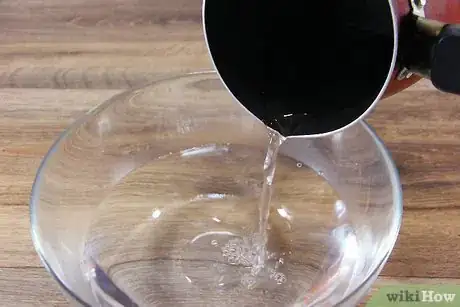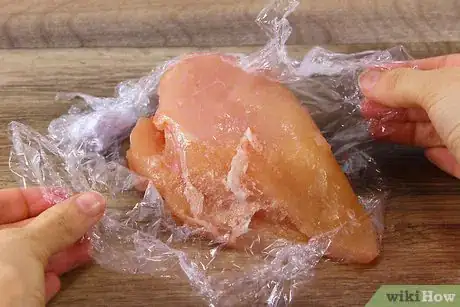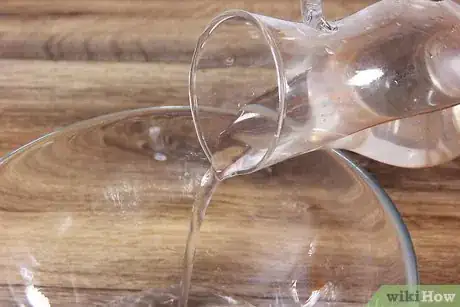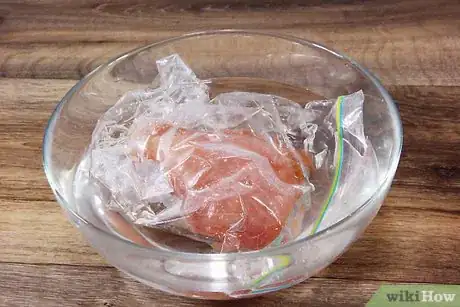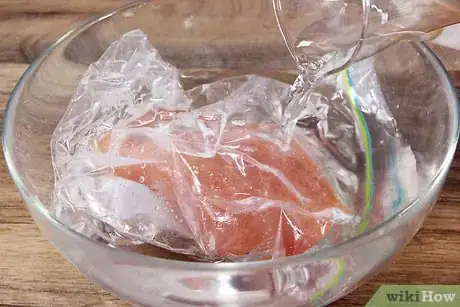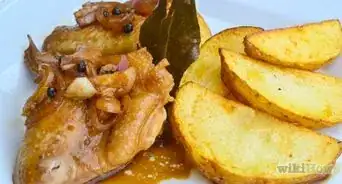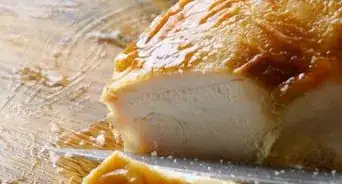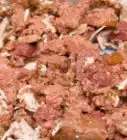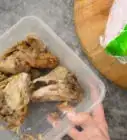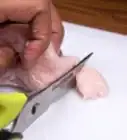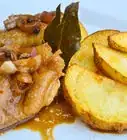This article was co-authored by Sasha Reyes. Chef Sasha Reyes is the Executive Chef and Owner of Artisan Personal Chefs. With over 20 years of food industry experience, she specializes in private dinner parties, custom sports nutrition plans for professional athletes, and cooking lessons. Chef Reyes graduated from Arizona Culinary Institute in 2011 with a degree in Culinary Arts, Baking, and Restaurant Management.
There are 13 references cited in this article, which can be found at the bottom of the page.
This article has been viewed 22,822 times.
You may have forgotten to take the chicken out of the freezer, but that doesn’t mean dinner is ruined. If you need to heat up thin cuts like chicken breasts, a hot water bath is the simplest way to defrost them. Using a microwave is the most rapid way, but it requires some precautions to defrost the chicken evenly. To defrost larger cuts and whole birds, the only solution is to soak the meat in a cold water bath.
Steps
Thawing with Hot Water
-
1Place the meat in a sealed bag. Get a resealable plastic bag for each piece of chicken you need to need to defrost. While you can keep the meat in its original packaging, most times it’ll be too big to fit in a bowl of water.[1]
- Placing multiple pieces of chicken in the same bag is okay as long as you are able to lay the meat in a single layer.
-
2Fill a bowl with 140 °F (60 °C) hot water. Choose a bowl big enough to hold the chicken you wish to thaw. If you don’t have a bowl, try heating the water in a large pot on the stove. Add the water, then check its temperature with a kitchen thermometer.[2]
- Water around this temperature is not hot enough to melt the plastic into your food, but it will cook the chicken a little if you aren’t careful. To prevent this, avoid using water hotter than 140 °F (60 °C).
Advertisement -
3Submerge thin cuts of chicken in the water. Drop the sealed chicken into the water, pushing it down so it is completely covered. This only works with thin cuts of meat like 1 in (2.5 cm) chicken breasts. Bigger items like whole birds will not thaw evenly in hot water.[3]
- If you heated the water on the stove, remember to move the pot off of the heat source to prevent it from warming further.
- Thaw large cuts of chicken in the microwave or in cold water. If you try thawing them in hot water, bacteria will spread, potentially making you sick!
-
4Thaw the chicken for about 10 minutes, stirring the water frequently. Swirl the water around with a mixing spoon about once a minute to keep it at an even temperature. Chicken thaws quickly this way, although some cuts may require a few extra minutes. Check the water as needed to make sure it’s hot enough.[4]
- If you notice that a piece of meat is going to take longer than 30 minutes to defrost, get it out of the water immediately and finish it in the microwave.
-
5Remove the chicken and cook it while it’s safe to use. The chicken will look a little opaque when it’s done defrosting. Take it out of the bag right away so bacteria doesn’t begin to grow on it.[5]
- Once a piece of meat reaches 40 °F (4 °C), bacteria starts multiplying at a rapid rate. Leaving the chicken in the water keeps it at this temperature for too long, making it unsafe to eat.
Defrosting Chicken with a Microwave
-
1Remove any plastic covering the chicken. Microwaving plastic isn’t safe and you will need to be able to reach the chicken to help it defrost. A lot of store-bought chicken comes in a tray with plastic wrap, so peel off the wrapping to expose the chicken.[6]
- The exception to the plastic wrap rule is when the chicken comes in a microwaveable bag. Check the labels and instructions for recommendations. If you don’t see anything indicating that the plastic can be microwaved, don’t risk it.
-
2Arrange the chicken evenly on a microwave-safe container. Spread the chicken pieces out in a single layer in a bowl or on a plate. Use cuts of an even size when microwaving multiple pieces of chicken at the same time. For cuts of varying sizes, consider microwaving them one at a time to ensure they defrost through.[7]
- Cuts defrost at different rates depending on their size. To make the defrosting process smoother, try pounding pieces to a similar thickness with a mallet or another blunt object.
-
3Set the microwave to a defrost or reduced power setting. Some microwaves have a built-in defrosting function, so check yours for an easy way to get the process started. If your microwave doesn’t have this setting, reduce the power setting to 50% to thaw the chicken at a safe rate. Lower power settings are also safe to use but will defrost the chicken at a slower rate.[8]
- Check your microwave’s owners manual for instructions on how to adjust the power setting. Most models have a “power level” button that makes defrosting a breeze. It's also important to know your microwave manufacturer's recommendations, to avoid accidentally cooking the chicken.
-
4Microwave the chicken for about 2 minutes. Let the microwave run without opening the door. The outer edges of the chicken and thinner portions thaw first. When defrosting works correctly, these portions won’t have a chance to begin cooking before the rest of the chicken thaws.[9]
- Leaving the chicken in for too long will cause the outer edges to cook. Only defrost the chicken for 2 minutes or less at a time and always use a low power setting.
-
5Flip the chicken over, then defrost it for another 2 minutes. Pull apart any pieces of chicken stuck together. Keep them arranged on the plate in a single layer. After another 2 minutes in the microwave, check the chicken to identify any cold spots left. Cook the chicken immediately after it finishes defrosting.[10]
- If you notice cold spots, continue to defrost the chicken for 30 seconds at a time. The center of each cut thaws last, so be sure to check it each time.
- Moving the chicken around helps, especially if you don’t have a rotating tray in your microwave. Position the coldest parts near the microwave’s heat source to encourage them to thaw
Using a Cold Water Bath
-
1Store the chicken in a sealed plastic bag. Break up the chicken as needed to fit it into the bag. Leaving the chicken in its original packaging is fine as long as the plastic cover is waterproof. Test the container to make sure it is leak-proof before you attempt to submerge it in water.[11]
- The plastic wrapping around store-bought chickens is generally waterproof, making a cold water bath the fastest way to defrost them.
-
2Fill a bowl with cold water below 40 °F (4 °C). Run cold water from your sink tap and fill a bowl big enough to hold the chicken. For whole chickens, fill your sink for an easy way to create a water bath. You do not need to add ice or anything else to the water; just be sure the water is cool.[12]
- Water above 40 °F (4 °C) is too warm and will cause the chicken to reach an unsafe temperature.
-
3Submerge the chicken in the water bath. Set the chicken in the water to begin defrosting it. Make sure it is covered so it thaws evenly.[13]
-
4Change the water out every 30 minutes until the chicken is done. The water warms up over time, so test the water with a thermometer or your fingers. If the water no longer feels very cold, drain it and fill the bowl with more cold water. Cold water baths require lots of babysitting, but doing this is the only way to defrost large cuts of chicken quickly and safely.[14]
- A 1 lb (0.45 kg) pack of chicken defrosts in 1 hour or less. Anticipate anything larger to take about 30 minutes per 1 lb (0.45 kg).
- If changing the water isn't an option, drain the water in the sink. Turn on the tap instead. Keep the chicken under a steady stream of cold water until it thaws.
Warnings
- Improperly defrosted chicken is unsafe to eat. Once the chicken reaches 40 °F (4 °C), bacteria multiplies on it. Defrost chicken with caution and throw away spoiled meat.⧼thumbs_response⧽
Things You’ll Need
Thawing with Hot Water
- Bowl or sink
- Hot water
- Plastic bags
- Stove
- Pot
Microwaving Chicken
- Microwave
- Oven-safe bowl or plate
- Meat mallet for uneven chicken
- Plastic wrap for uneven chicken
Using a Cold Water Bath
- Bowl or sink
- Cold water
- Plastic bags
Expert Interview
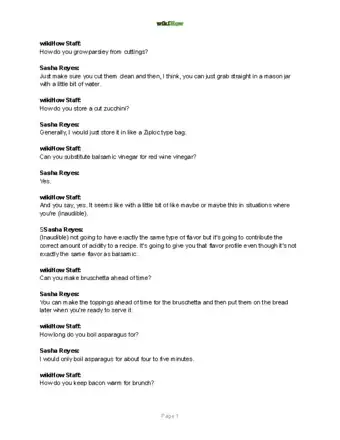
Thanks for reading our article! If you'd like to learn more about cooking hacks, check out our in-depth interview with Sasha Reyes.
References
- ↑ http://dish.allrecipes.com/best-way-thaw-chicken-breast/
- ↑ https://www.youtube.com/watch?v=4a2hQpj6Dxc&feature=youtu.be&t=16
- ↑ http://dish.allrecipes.com/best-way-thaw-chicken-breast/
- ↑ https://www.youtube.com/watch?v=4a2hQpj6Dxc&feature=youtu.be&t=50
- ↑ https://onlinelibrary.wiley.com/doi/abs/10.1111/j.1750-3841.2010.02037.x
- ↑ https://www.stilltasty.com/Articles/view/88
- ↑ https://www.stilltasty.com/Articles/view/88
- ↑ https://www.stilltasty.com/articles/view/9
- ↑ https://www.epicurious.com/expert-advice/how-to-thaw-every-food-in-the-microwave-oven-article
- ↑ https://themom100.com/2017/12/safely-thaw-frozen-chicken/
- ↑ https://www.purewow.com/food/how-to-defrost-chicken
- ↑ https://www.self.com/story/all-the-different-ways-to-thaw-chicken-breasts-ranked
- ↑ https://www.eatwell101.com/how-to-thaw-frozen-chicken-fast
- ↑ https://www.fsis.usda.gov/wps/portal/fsis/topics/food-safety-education/get-answers/food-safety-fact-sheets/safe-food-handling/the-big-thaw-safe-defrosting-methods-for-consumers
- ↑ https://www.fsis.usda.gov/shared/PDF/Big_Thaw.pdf
About This Article
If you need to defrost thin cuts of chicken fast, start by placing the meat in a sealed bag, then submerging the bag in a bowl of water that's 140 degrees Fahrenheit. Leave the chicken underwater for about 10 minutes while stirring the water frequently. When it starts looking a little opaque, cook it immediately so it's still safe to use. Alternatively, you could try defrosting your chicken by placing it in a microwave-safe container and setting the microwave to a defrost or reduced power setting. After you let the microwave run for 2 minutes, flip the chicken over and defrost it for another 2 minutes. Then, make sure to cook it as soon as possible, since bacteria grows rapidly on meat that's 40 degrees Fahrenheit. For more tips, including how to use a cold water bath to quickly defrost a chicken, read on!

